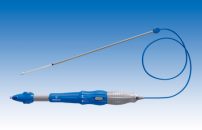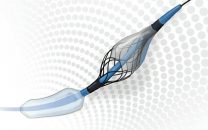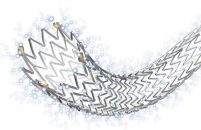Courtesy of Dr. Carlos Fava. The transradial approach has been advanced in time, and is being increasingly used in more and more complex angioplasty procedures with the same benefit, compared to the classical femoral approach. As a result, in many high volume centers, this reality has demoted the femoral approach to a few particular procedures.…
Evolut R: Clinical Results Might Be Better than Those for First-Generation CoreValve
Two recent articles featured in JACC Cardiovascular Interventions showed that short term (at 30 days) outcomes of patients treated with the next-generation self-expanding Medtronic Evolut R valves could present several advantages compared to the original CoreValve, including recapturability. Both analyses reported similar rates of all-cause mortality and stroke. The study carried out by Dr. Jeffrey Popma as…
Double Kissing Crush vs. Provisional Stenting at 5 Years
Courtesy of Dr. Guillermo Migliaro. The Provisional Stenting technique (PS) consists of sequentially placing a stent in the main branch of the bifurcation and, only when faced with a suboptimal outcome (such as < 3 TIMI flow, flow limiting dissection or high residual stenosis), a second stent in the side branch. Several studies have shown…
Post-Dilation of Self-Expanding Valves: Frequency, Usefulness, and Risks
This study explores the impact of balloon post-dilation on studies conducted in the United States assessing the CoreValve self-expandable valve. Procedural details of 3532 patients were examined to determine whether post-dilation was performed after valve implantation. Best practice guidelines recommend post-dilation to improve suboptimal outcomes, being the most frequent alternative for treating moderate or severe…
New Generation of DES already being tested, so far safe
This study evaluated the safety and efficacy of the new drug eluting stents (Medtronic, Santa Rosa, California) to treat de novo coronary lesions. These new polymer free drug filled stents have the potential to improve clinical outcomes and allow a shorter dual antiplatelet therapy. In addition, they have been made with three layers of continuous…
The ReACT Study: Is Angiographic Follow-Up Necessary?
The purpose of this study was to assess the long-term clinical impact of routine angiographic follow-up after coronary angioplasty. Routine angiographic follow-up has been criticized by both clinical and interventional cardiologists for increasing the rate of coronary revascularization due to the “oculostenotic reflex.” This caused a shift in the paradigm for clinical studies, and…
Remote Ischemic Preconditioning in Carotid PCI: Safe and Effective?
Remote ischemic preconditioning (RIPC) can prevent recurrent ischemic events in patients with acute or chronic cerebral ischemia. However, is remains unclear whether RIPC could prevent an ischemic event in the context of carotid PCI in patients with severe carotid artery stenosis. The study included patients with severe carotid artery stenosis randomized to RIPC, vs.…
How Important Is Controlling Risk Factors for the Prevention of a Stroke?
There has been a recent decline of about 20% to 40% in the incidence of cerebrovascular accidents (stroke). Although this is attributed to the improvement of risk factor control, the reason behind it is not utterly clear. This study estimated the impact of modifiable cardiovascular risk factors on the incidence of stroke between 1995 and…
Asymptomatic Severe Aortic Stenosis in the Elderly: When to Intervene
This work studies the natural history of aortic stenosis and the optimal timing to intervene elderly patients with asymptomatic severe aortic stenosis. This disease is increasingly misdiagnosed in the elderly population, and this goes hand in hand with enhanced therapeutic options. Prior studies on the natural history of this disease were made on…
TAVR: Reasons to Consider Mitral Annular Calcification
Courtesy of Dr. Carlos Fava. Aortic valve calcification and mitral annular calcification have the same etiology and are frequently present in high-risk patients undergoing transcatheter aortic valve replacement (TAVR). The implications of mitral annular calcification for patients undergoing TAVR has not been entirely clarified yet. The study examined 782 patients with severe aortic stenosis who underwent…









